Envy
Neither shalt thou desire thy neighbor's wife, neither shalt thou covet thy neighbor's house, his field, or his manservant, or his maidservant, his ox, or his ass, or any thing that is thy neighbor's.
Deuteronomy 5:21
Envy is specifically forbidden in the Ten Commandments of the Christian Bible. Still, as a race we humans seem to be almost hard-wired to react to other people’s success with envy.
Sometimes envy can be benign. Seeing a famous musician playing in front of an admiring audience might be the inspiration that a child needs to practice her scales. However, as Mark Alicke and Ethan Zell point out in the book Envy: Theory and Research,“People who are more attractive, more popular, smarter, wealthier or more skilled cast other people’s own qualities in a disadvantageous light. There is a fine line, therefore, between admiring people’s superiors and basking in their accomplishments, and envying them and wishing them ill will.”
And that’s where envy gets nasty. Evolutionarily, to be seen as the most attractive mate, it’s not sufficient to have a lot of something; you have to have more than others around you. That makes us inequality averse to use a term from economics. In other words, we hate feeling like we’ve lost out. That feeling of deprivation, inferiority, or shame is the basis of destructive envy.
With destructive envy, it’s not just that we want the thing that someone else has; we also want that other person to not have it because their having it makes us feel inferior. In these situations, we make decisions based not just on benefit to ourselves, but also to make gains over others around us. So, even if we found ourselves in a situation in which we could gain more by cooperating with someone, destructive envy dictates that we’d often rather not work together than be in a position in which that other person benefitted more than we did.
Whether the root of someone’s envy is benign or destructive, it’s a powerful motivating force. That means it can be harnessed to make customers do things.
Manufacturing envy through desire and aspiration
To use envy as a motivating force, it has to first exist. The precursors of envy are aspiration and desire, and much of the publicity around products is designed to create those feelings.
Publicity persuades … by showing us people who have apparently been transformed and are, as a result, enviable. The state of being envied is what constitutes glamour. Publicity is always about the future buyer. It offers him an image of himself made glamorous by the product or opportunity it is trying to sell. The image then makes him envious of himself as he might be.
John Berger: Ways of Seeing
Aspiration leads to benign envy by creating a wish to emulate what we see. Desire can lead to benign or destructive envy by creating a wish to have what we see, and to even stop others from having it.
If nobody desires an object, that object is unlikely to create envy. Because envy is such a strong motivator, persuasion works by first creating desire and then leveraging that desire with envy. Some ways to create desire include:
- Secrecy: Being one of the few in the know about an item.
- Scarcity: Small numbers, low availability of the item.
- Identity: Identify the item with a desirable lifestyle, person, or activity.
- Aesthetics: The item is pleasing to look at, hold, and use.
- Functionality: The item solves a problem nobody else is solving.
Apple hits all these marks with its hardware. It is secretive leading up to a launch, which creates large quantities of speculation. People stand in line for days waiting to be the first to have the new product. The newly launched product then typically sells out fast, creating scarcity. Celebrities tweet about or are seen with the product, which is typically pleasing to look at and has a unique interaction design that solves problems in an elegant manner, especially if it provides functionality that solves a problem that people didn’t previously know they had.
The aesthetics of Apple products work on a visceral level. People respond positively to attractive faces, symmetrical and rounded objects, and soothing colors and sounds. Even the front-facing camera mimics the beauty spot from another aesthetic icon.
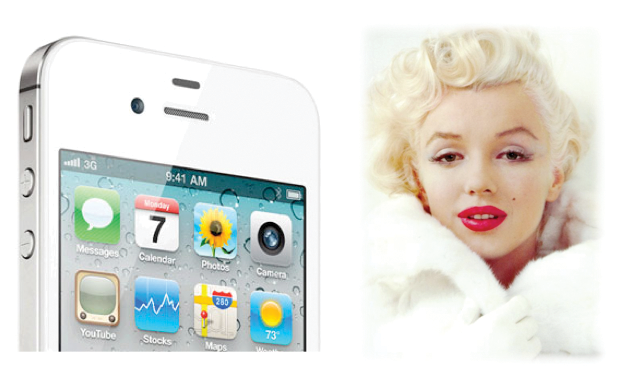
The end result is large quantities of desire. That desire leads to envy, sometimes more than even Apple would have expected. In early 2012, criminals mugging people for their phones around Columbia University in Manhattan were not interested in Android devices, only iPhones. New York mayor Michael Bloomberg even blamed the rise in the city’s annual crime index on the 3890 extra iPhones that were stolen in the city in 2012. The thefts may have something to do with iPhones having higher resale values, but then resale values are also driven by desirability.
- Secrecy: Provide little information about the substance or timing of a product release. Let a small group of well-connected individuals know what’s happening, and wait for them to leak small details. This works best if your business has already established other elements of desirability.
- Scarcity: Make a release exclusive (through price or quantity) or just hard to find. Have sufficient product waiting in the wings for when the panic buying starts.
- Identity: The staple of print advertising. You don’t get a bikini-clad model free with every bottle of sunscreen you buy, but you’d expect this to be the case given the frequency of association in ads.
- Aesthetics: The design, feel, and usability of the product must resonate with your target audience. This is hard to fake—it takes real work to make an aesthetically pleasing product.
- Functionality: Identify and then solve a problem that nobody else has solved. Although not easy, this is extremely effective. Even solving small problems can have a big payoff.
Lifestyle magazines aren’t aimed at who they say they are: Cosmo is aimed at 17-year-olds; Just 17 is aimed at 13-year-olds who aspire to be as grown up as 17-year-olds.
Although there is a big aspirational market for a magazine called Better Homes and Gardens, you wouldn’t expect to find one called Double Wide Weekly or Mobile Home Monthly because mobile homes are often the first step on the property ladder. Actually though there is such a magazine: it’s called Upwardly Mobile Home Magazine, the magazine of mobile, manufactured, and modular home living, and it’s all about making mobile homes posher. In other words, it’s still totally aspirational.
Aspiration—a form of benign envy—encourages people to emulate their idols and fuels ambition. Creating desirability through association with a famous person (desirability through identity) is the basis of celebrity endorsements and the reason why movie stars don’t pay for the dresses they wear on the red carpet at the Oscars award ceremony.
Fashion from Paris catwalks and the red carpet at the Oscars makes its way into high street stores and big box retailers quickly because wearing something visibly similar to the haute couture clothes is aspirational.
Given that people will emulate their idols, there is obviously a place for idols to endorse products online in more creative ways than just appearing in advertisements. Leveraging aspiration online has even extended to Twitter. Now, companies can pay celebrities to tweet 140 characters about their brand or latest campaign. Sponsoredtweets.com has a sliding payment scale based on the popularity of the celebrity. Jamie Oliver (celebrity chef) costs $3,250 per tweet, Khloe Kardashian (reality TV star) is $9,100, and Bob Vila (house repair TV host) is a bargain at just $910. If you have to ask how much Paris Hilton costs, you can’t afford her.
What happens when you approach envy from the other side? Susan Fiske, a professor of psychology at Princeton, argues that while we look up to the “haves” with envy, we look down on the “have nots” with scorn, especially around economic issues. Rich people are viewed as competent yet cold, poor people as incompetent yet warm. We are always comparing ourselves against others, and when we look down with scorn, we’re saying “You aren’t worthy of my attention.”
Clever marketing embraces both aspiration and scorn. Ad campaigns showing someone giving his spouse a luxury car wrapped in a big red ribbon as a Christmas present speak volumes about the prestige associated with driving one of these vehicles. Viewers compare themselves to the couple in the advertisement. This reinforces the aspirational feelings that envious would-be buyers have about the brand. For those who can already afford the car, the message still resonates and creates scorn for those who can’t.
Sponsoredtweets’ rate sheet (March 2012; sponsoredtweets.com)

The trick in providing a balance that allows both envy and scorn is that you mustn’t be too out of range. Nokia’s deluxe Vertu handsets have keys individually cut and ground from sapphire, gliding on ruby bearings similar to the internals of expensive watches. The cases are clad in 18-carat gold, alligator leather, and precious stones. The London Symphony Orchestra creates the phones’ ringtones. This type of manufacturing obviously comes at a price. Handsets range from $3,500 up to $310,000 (yes, for a phone).
The musician Seal apparently uses a Constellation Quest phone. This model retails for $8,400. A USB data cable costs just $190. Is this aspirational, or so inaccessible to just be scornful? Either strategy can work as a marketing technique. (vertu.com)

Of course, wherever there is aspiration that is so obviously out of reach, there is the opportunity to make money from affordable fakes, which let people “live the dream” of the expensive brands without taking out a second mortgage. For less than one-tenth of the price of the real item, you can purchase a knockoff that carries the name, if not the quality, of the original and unachievable product.
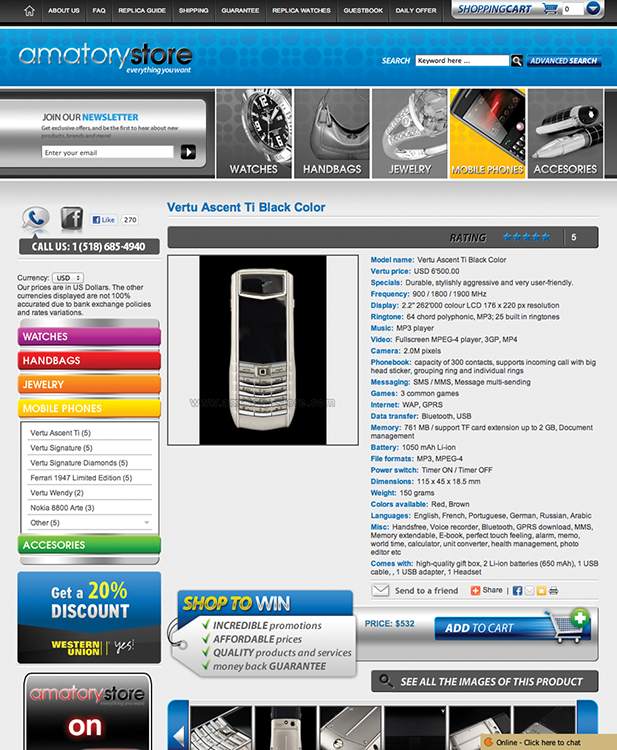
The less virtuous Vertu is the knockoff available on this site. People who aspire to own a Vertu still pay more for this fake than they would for a full-function brand-name smartphone. (amatory.biz)
- Show your product in settings that would be aspirational for your target audience. This may include showing it being used by aspirational individuals or to achieve end results that your audience aspires to.
- Provide a comparison point: What does your product provide “more” of for customers? Will users be richer, more popular, smarter, or all three?
- Be careful of leveraging scorn. Being envious gives people feelings of guilt, but being scornful often leads to dehumanizing of the scorned group, which can have dangerous repercussions.
- Consider as a secondary audience any group who is one or more notches lower on the scale (age, income, leisure time, and so on) than your current target audience. Develop a product offering for that group that helps them meet their aspirational goals. If you don’t, someone else will.
In his book Emotional Design, Don Norman states that we are much more emotionally attached to products for which we feel some involvement. This is true even before we own the product. Clever sites invite us in and make us feel like a member of the family before we even part with our cash.
BioLite is a revolutionary camping stove design that burns wood and other biomatter cleanly and efficiently through gasification. The idea is old (cars used similar gasification burners in post-war Germany where petrol was scarce), but the technology needed to create a small, portable, reliable stove was untested.

The company first promised an early 2010 release, which subsequently slipped to late 2011 and then Spring 2012. Its design finally came to market in May 2012.
What kept people interested enough during that time? The company could have worked in stealth mode. After all, there was always the potential for another company to “borrow” the idea and get to market sooner. Instead, it chose to keep its website updated at each stage of the journey. It showed video of early prototypes used in the woods, listed the design awards it was winning, and consistently tied the commercial camping stove product back in with its charitable work to develop low-carbon, high-efficiency cooking stoves for developing nations. It also updated the design by making the stove lighter and adding a USB port to recharge electronic devices using the excess energy generated by the clever heat-to-electricity generator that powers the stove’s fan.
This constant communication, coupled with well-placed PR mentions in Outdoor magazine, Wired magazine, and on influential sites such as TechCrunch and Gizmodo meant that people who were interested in purchasing the camping stove could see regular updates. The charitable work acted as proof of concept, and the fact that sales of the camping stove would subsidize creation of the larger home stove for developing nations gave potential customers the feeling that they’d be supporting a worthwhile cause. The videos allowed people to see how the product could apply to them before it was available.
All-in-all, the company’s site made potential customers feel like they were already part of the BioLite “family” even though there was no tangible product to purchase.
This story isn’t unique. In the digital realm, three months prior to releasing the game Spore in September 2008, Electronic Arts made the SporeCreature Creator (a way to build characters for the game) available as a free download. The Creature Creator was a game in itself. After choosing a body, limbs, features, and decoration, users could make the monster that they had plugged together dance, sing, and react. This was one of the first times that players could easily build their own fully rendered game characters from the ground up. Experiencing the smooth animation of a custom-built monster fuelled desire among potential customers to see how the character they’d built would perform in the game world. This in turn drove sales of the game, which moved more than two million copies in the first three weeks and was a top-10 PC game through 2009. Will Wright, the creator of Spore, observed that it took Spore fans just 18 days to create the same number of species as exist on earth, which meant they were working at 38 percent of the efficiency of God.
The Spore creature creator gave users a feeling of “owning” the character they developed before the full game was available. (spore.com/trial)

Kickstarter’s whole business model could be described as making people feel ownership before they’ve bought a product, or indeed before it’s even been made. The idea is that you pledge money and become a backer of a proposed creative project. Obviously, if the project doesn’t meet its funding goals you aren’t billed. That means that if you want the product, it’s in your interest to persuade as many other people as you can that they too should get involved.
With three hours to go, Double Fine had already easily become the highest financed Kickstarter project in the site’s history. The Double Fine project pushed all the right pre-ownership buttons. (kickstarter.com)
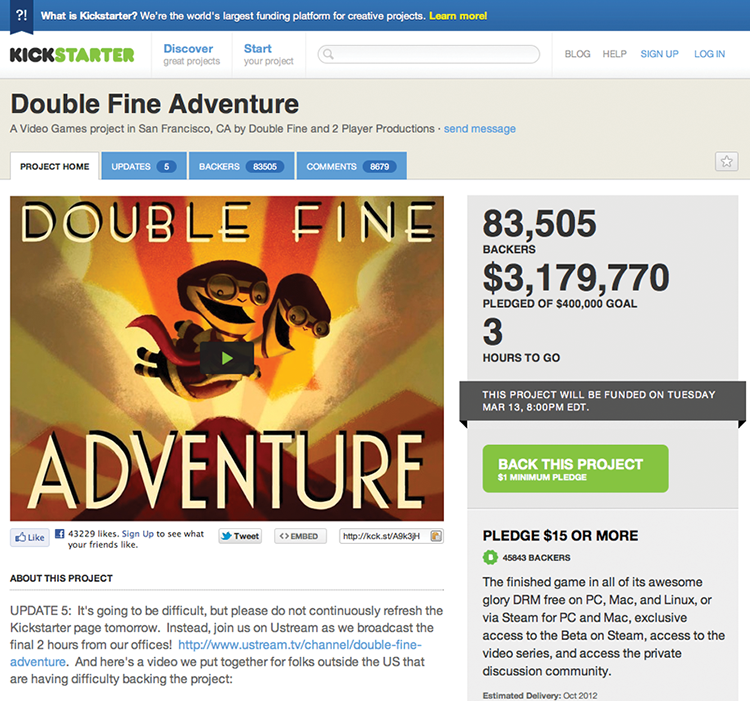
One example of a successful Kickstarter project is Double Fine Adventure, a point-and-click computer game. At the time of funding, backers knew only that Tim Schafer, the project’s leader, had a history of producing engaging adventure games. No work had been done on a script, character development, or any other aspects of the game. Based on nothing more than reputation and a promise to include backers in regular updates as the game development process progressed, Tim met his funding goal of $400,000 in just eight hours. Even he was surprised when funding topped the one million dollar mark within twenty-four hours. By the time the Kickstarter project closed, he had 87,142 backers for a total donation of more than $3.3 million. That left him 834 percent funded, and therefore he could add more characters and better technical effects, and release on more platforms and in more languages than he had ever intended.
To increase the chances of success, most Kickstarter projects draw people in with escalating rewards for pledges at different levels of involvement. Double Fine Adventure promised a copy of the game to people pledging at the $15 level, with various stages including signed books and posters at $500 up to lunch and a tour of the offices at the $10,000 level. Variable pledge levels allow people to “buy in” to the project at different levels of support. Especially at the higher levels, the money that people give is almost definitely more than the value of the goods, yet for Double Fine Adventure all one hundred of the $1,000 level pledges and all four of the $10,000 level pledges sold.
- Show people how your product can apply to their lives so that they get and remain excited about it through the prepurchase phase.
- For products that have yet to be released, provide frequent status updates, teases, and reveals (leaks). However, never over-promise.
- For physical products, provide a configurator that lets people play with product options and swap pieces in and out. This allows people to personalize the product, which can give them greater attachment to it. Make the configurator as visual as possible so that people can easily fall in love with their creations.
- Offer demonstration versions of your product so that people can give it a trial run. Although you might feel the urge to remove some functionality or create a time limit on the demo version’s life, users must be able to create and share output from the demo to feel a desire to own the full product.
- Less sexy products can also create prepurchase desire. Testimonials, reviews, and white papers serve this purpose so long as they describe real use cases and quantifiable outcomes.
- Encourage potential customers to participate in a forum where they can get their questions answered by people who already use the product. When they feel like part of the community, they’ll slip more easily into the purchase process.
- Create different levels of reward for different levels of engagement; the more people engage, the closer they get to being “family.”
Status envy: demonstrating achievement and importance
In a totally egalitarian universe, envy couldn’t exist. There need to be differences in status for envy to work. If you want to use (benign) envy to drive people to a certain goal, then you need to show them the difference between their current status and the status they can achieve if they reach the goal.
There are indications of status—and status differences—everywhere. Even in supposedly “classless” societies such as the USA, there exists a wide range of social strata, as brought to light by the Occupy movement, and plenty of opportunity for envy, as shown by talk of the “one percent.”
Employing envy as a motivating factor therefore means highlighting the differences in status. You can do this effectively by showing successful users’ achievements and importance in a public manner.
Envy and scorn work because there are two groups: those that have and those that have not. Members of the group who do not have the thing are envious of the group who does have it, who in turn scorn those who do not.
One group who you wouldn’t expect to see using status differences as a sales point is religious organizations. That however doesn’t stop some people from offering services that play on status differentiation to a particularly religious group.
The site youvebeenleftbehind.com enables Christians who believe in a relatively imminent Rapture event (true believers are suddenly taken up to Heaven, everyone else remains behind in Tribulation) to make contact with those who are “left behind.”
As status differentiators go, this is quite big. It’s hard not to see this as a form of inverted envy, or scorn. Indeed, the site plays on this:
Imagine how taken aback [your friends and family] will be by the millions of missing Christians and devastation at the rapture. They will know it was true and that they have blown it. There will be a small window of time where they might be reached for the Kingdom of God. We have made it possible for you to send them a letter of love and a plea to receive Christ one last time.
youvebeenleftbehind.com/why.html
So from this perspective, the Rapture is something exclusive. If you live by a certain set of rules, you get the special treatment and many others do not. The promise of special treatment might be a good enough reason for some people to choose to live by those rules in the first place, but last time I checked, piety is typically one of the rules and smugness is not. Especially not when it leads to presumptuous bumper stickers like “Warning: in case of Rapture this car will be unmanned.”
youvebeenleftbehind.com makes a clear distinction between the haves and the have-nots. It then exhorts the haves to “pity” the have-nots by sending a last invitation to join the club.
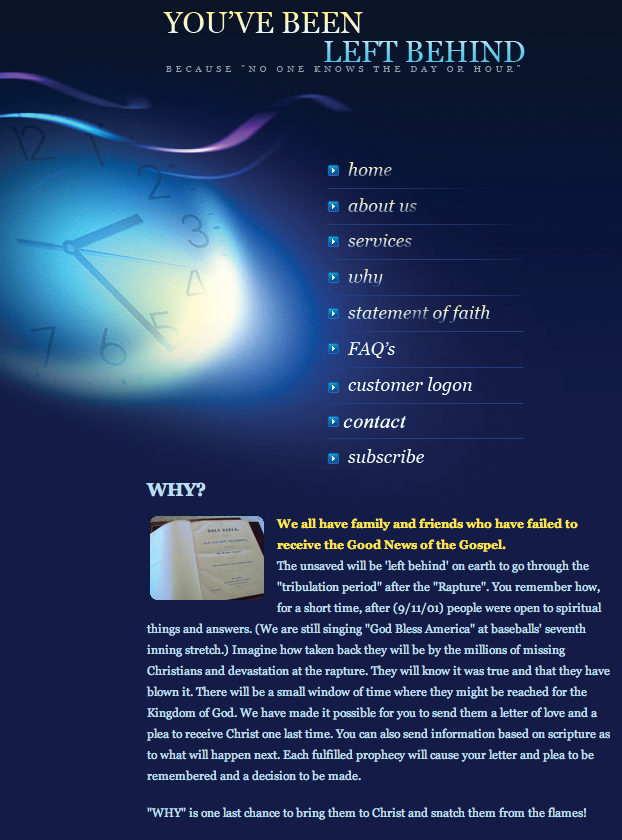
The security researcher Bruce Schneier pointed out an especially clever aspect of the youvebeenleftbehind.com business model. Although the site provides few clues about the owners’ backgrounds, these owners suggest that their servers are an ideal place to store details on every aspect of your financial life. Indeed, until Schneier called it out, the site used to have a sales pitch directed clearly at this point:
In the encrypted portion of your account you can give them access to your banking, brokerage, hidden valuables, and powers of attorneys' (you won't be needing them anymore, and the gift will drive home the message of love). There won't be any bodies, so probate court will take 7 years to clear your assets to your next of Kin. 7 years of course is all the time that will be left. So, basically the Government of the AntiChrist gets your stuff, unless you make it available in another way.
youvebeenleftbehind.com (This text was removed in 2008, but the sentiment remains.)
Given the highly trusting nature of the potential audience for this service, it’s hard to know whether the service is an example of good gone wrong, or just plain evil.
In a nice counterpoint, a group of atheists has got in on the act as well. Eternal Earth-Bound Pets are “a group of dedicated animal lovers and atheists. Each Eternal Earth-Bound Pet representative is a confirmed atheist and as such will still be here on Earth after you've received your reward. Our network of animal activists are committed to step in when you step up to Jesus.”
Bart Centre, who runs the service, doesn’t mince his words: "I'm trying to figure out how to cash in on this hysteria to supplement my income." And at $135 per pet, he’s likely to do quite well, given that he has nothing to lose: "If we thought the Rapture was really going to happen, obviously our rate structure would be much higher."
- Show how your group is different—and better—than other groups.
- Create opportunities for users to pity or scorn the other groups.
- Offer a service that is exclusive to the group.
- Bonus points for creating a differentiation in which people pay to pour scorn on you (for instance atheists offering a service to believers).
You wouldn’t pay $20 at the departure gate to board an airplane earlier, but you might choose to fly with an airline that gives you that privilege as part of a mileage rewards plan, even if the ticket ends up costing you $20 more. Why? Because you too can be “Elite” and get that extra five inches of legroom if you just slug it out in cattle class for another fifteen trips.
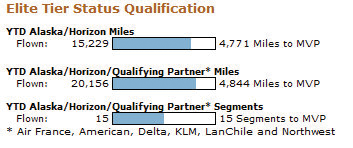
The airline is counting on the envy that all the other passengers feel as they watch the early boarders fill up the overhead bins, and as they traipse past the frequent fliers who got first class upgrades on the way to their seats at the back of the plane.
By encouraging the desired behavior in passengers time after time, passengers start to develop habits around that company. After a while, the habit becomes sufficiently ingrained, and the impending reward becomes sufficiently achievable, that passengers stop comparing prices so diligently and just go with the familiar airline.
The strength of this perceived reward is all in how you show it, though. The member-only perks must be seen as sufficiently valuable. For something like grocery store reward cards, the differential pricing is sufficient reward, even if it works more as a punishment for nonmembers than an incentive for members. The lure of airline rewards is that by being loyal to the airline rather than using price-check sites like Kayak or Orbitz, you can gain more creature comforts and even free flights in the future.
Loyalty programs need to seem enticing right from the beginning, so it’s important to “prime” an account. Joseph Nunes and Xavier Dreze ran experiments that determined that car wash loyalty cards were more likely to be redeemed if they were given to customers with 10 purchases required of which two were already clipped than if they were just a straight 8 purchases required.
Mileage plans and awards-based credit cards work the same way by giving a signing bonus, for instance by adding a large number of awards upon opening a credit card account. Bagchi and Li found that it’s also better to give people large numbers of points, even if the goal is equally distant. Offering 10 points per dollar, with 1,000 points needed, works better than offering 1 point per dollar, with 100 points needed because as they get closer, people see a bigger progression toward their goal.
The reward doesn’t have to be financial. Xbox achievement points, while not a draw for all gamers, might make a game more appealing to purchase and play for obsessive achievement unlockers. PlayStation3 has a similar achievement-based system using trophies. Even Visual Studio—a software development platform for writing code—now has achievements built in.
Achievements make it apparent what skills somebody possesses. By unlocking certain achievements within a game, that individual obviously managed to master a particular set of moves or demonstrate a specific level of skill. Now, rather than just being “good” at a game, it’s possible for players to quantify exactly how good and at what specific things. Although this probably doesn’t mean that programmers are going to start writing their Visual Studio achievement scores on their resumes, it does give others who care about such things a measure of the status of an individual.
Achievement unlocked. © Derek Lieu, Kick in the Head Jan. 18, 2011. (kickinthehead.org)
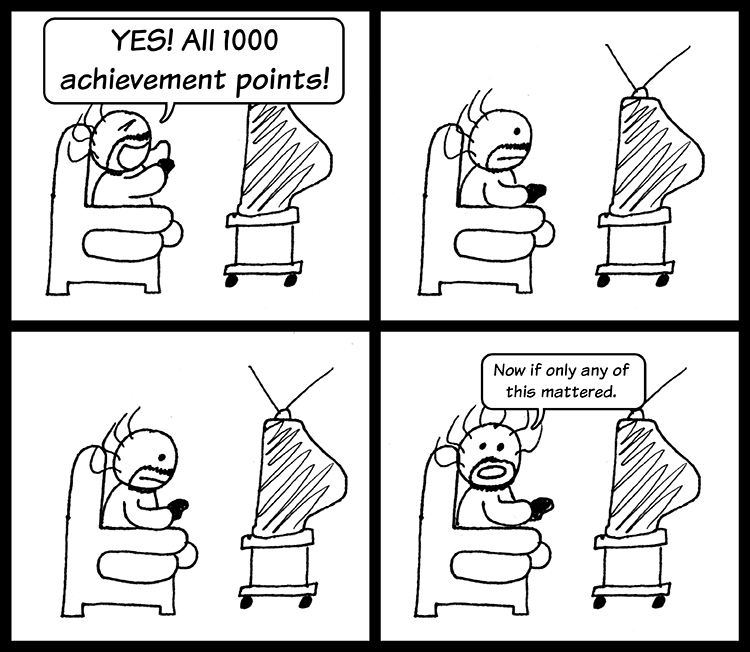
Achievements also benefit the game companies in several ways. First, the obsessives will buy each new game based on the number of achievement points it allows them to collect. Because points accrue per game, the more games you play, the more achievement points you can collect. Playing more games means buying more games.
But even regular gamers will unlock some achievements as they play. Information on which achievements get unlocked frequently and which are avoided helps the game developers to create future titles that fit better with gamers’ expectations. Often achievements will also have funny names based on in-jokes, so they provide entertainment value as well as collection value.
- Focus users’ attention on how many points they’ve gained, not how many they need for a reward.
- Help people on the way to achieving by priming their account to start with.
- Ensure that people can relate to the longer-term end goal they get with the awards system. Remind them constantly of the benefits that accrue with awards.
- Set and control the exchange rate so that people find it sufficiently valuable to stay with the program despite cheaper alternatives.
- If you offer several different types of achievement, tracking the popular achievements may give you an indication of which types of status are important to your audience, allowing you to make future offerings more attractive.
Part of the fun of playing World of Warcraft (WOW) is the social aspect of being online with ten million of your closest friends. The part that turns it into a game is the achievement and status that comes with successful quests.
However, it takes time and patience to reach a high enough level to make the game really fun. Luckily it’s easy enough to bypass the boring achievement part if you want instant status. You just have to pay someone else to do the hard work for you. The World Bank says that gold farming (the act of sitting in front of a computer performing repetitive tasks to “earn” in-game rewards) and power leveling (playing with the intent of gaining enough character status to then sell the character) was a $3B market in 2009, with a surprising proportion of that money actually going to the developing countries where the clicking takes place.
Characters.net is just one of many sites selling prebuilt characters to players who have more money than time.
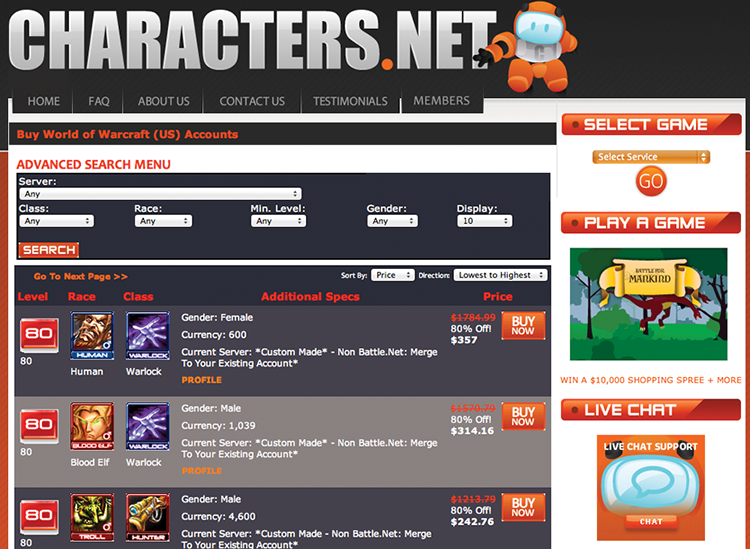
Now obviously the gold is valuable because the game developers made it take many hours of “grinding” to create goods that can be exchanged for gold. Characters are valuable only because of the time and experience it takes to nurture them through to sufficiently high status levels. When enough people start offering these third-party gaming services (the 2011 World Bank report suggests that 100,000 people may have been earning their primary income this way in 2009), the game companies must ensure that players don’t get disheartened by seeing their competition buying their way to success.
The official line from companies such as Blizzard, the makers of WOW, is that the virtual economy is wrong, that much of the gold on offer is stolen from compromised player accounts, and that people who buy rather than achieving are cheating. Blizzard specifically chose to build the game as a subscription rather than freemium (free to play, buy the extras you need) platform, and it suggests that players want to see it kept that way.
Unfortunately, new players have a harder time “leveling up” than experienced higher-level players who already have powerful magical tools, weapons, and armor at their disposal, and who can complete more complex quests that provide higher rewards. As Cory Doctorow (who researched gold farming for his novel For theWin) says “so long as [Massively Multiplayer Online games] look the way they do now, where there's that leveling path, and so long as the ways MMOs incentive players to go on playing after a long time is by creating lots of new levels they can ascend to, and so long as ascending to new levels gives you exponentially more access to power, wealth and sorts of enjoyment than you would have had otherwise, then that market will exist.”
Other games such as Farmville use a freemium approach, but the items you can buy in-game are typically tools to help you succeed or vanity items such as gifts, rather than the capacity to instantly level up. This type of purchasing is likely to continue and even increase after players reach higher levels in the game, whereas the need for out-of-game purchases of gold and status will diminish as the player’s in-game character becomes more powerful.
Encouraging payment rather than achievement also works for real-world tasks. GymPact (also mentioned in the chapter on Pride) “lets you set the financial stakes of not getting to the gym, plus earn cash rewards and real prizes for fulfilling your Pact.” The company is basically betting on laziness, despite encouraging people to work out. Dan Ariely, in his book Predictably Irrational, shows how providing the offer of payment (even in the sense of a fine) counterintuitively legitimizes an otherwise punishable activity, allowing people to feel OK about doing it because they paid for it. Ariely’s example is parents who were happy to pay a late fee for leaving their kids in daycare too long. It would be interesting to see whether GymPact has users who behave the same way, seeing payment as an alternative to achievement or even as a way of justifying not achieving.
- If your game or product revolves around escalating levels of achievement, it’s likely that people with more money than time will want to pay for a shortcut. Try to find a way to enable this out-of-game purchasing without alienating players who have more time than money.
- Own the exchange: Make sure that if people can pay to achieve status, they are paying you (or at least performing the transaction via your systems) rather than somebody else. This also allows you to set the exchange rate to maintain the value of status. Achievers should never feel disheartened, and payers shouldn’t stop paying.
- Ensure that there is a sufficient flow of items within the game/product to satisfy demand without oversaturating the market. That may mean creating a steady flow of new items over time.
- Try to minimize the guilt that people feel about paying instead of achieving. For instance, by donating a certain percentage of payments to a charitable cause, or by giving them the opportunity to “buy back” their payment with later achievements on a credit-like system. (It’s doubtful they ever will.)
- Allow payments as an excuse for not achieving.
In the real world, people advertise their status by the clothes they wear, the cars they drive, and even the places they choose to congregate. Online, many of those cues aren’t available, so they are replaced instead with other (potentially more democratic) measures of status such as reputation.
Reputation can be summarized in different ways depending upon the online context. For instance, in online games it might be the level and experience points that a character possesses. In social media circles it might be the number of “likes,” recommendations, mentions, back links, badges, or followers. In forums, it might be the number of posts or thanks received.
The xda-developers.com forum has different status levels. Posters start off as junior members and progress to senior members. Developers have special status levels (they are the reason the forum exists), and moderators are chosen from within the community based on participation. Thanks, posts, join date, and the ability to add a signature and image are all additional indicators of status.

Online communities require participation to be useful, fun places to hang out. With increased participation comes an increased requirement to police what is being discussed. Although people employed by the community provider to prevent abuse must undertake some of this policing, other community members often want to step in to an informal overseer role. It makes sense to encourage this as much as possible. It appears that most of the time status is a sufficient reward for these individuals. In other words, they are doing a job that would normally require payment just for the opportunity to have the title of “moderator.”
Other people see these higher levels of status and want to attain them because of the perceived benefits, so differentiating and displaying status levels creates an aspirational goal.
Awarding status is also a major retention opportunity because the status was hard-won and is difficult to transfer elsewhere. People are typically loss averse, so they will continue using a system rather than “losing” the status they have accumulated, even if there is no physical value attached to that status.
- People care about their status and the status of others in the environment. Make sure it’s easy for them to show and see the status of people they interact with.
- If you want to migrate to a new forum system, or entice forum moderators from a different platform, make sure that you give them an equal or better status in the new system.
- Try to make the status worthwhile achieving. For instance, in forums, status can also come with access to more tools such as the ability to ban users and promote, edit, or move postings.
- Higher status levels should require an element of work to achieve. The highest levels should be relatively exclusive to make them more desirable.
What do Dale Carnegie, author of How to Win Friends and Influence People and Mary Kay Ash, founder of Mary Kay Cosmetics, have in common? Other than both starting their careers as door-to-door salespeople, both also realized the potential of making customers feel special.
Mary Kay Ash said, “Pretend that every single person you meet has a sign around his or her neck that says ‘Make Me Feel Important.’ Not only will you succeed in sales, you will succeed in life.” This advice helped create a 1.8 million-person strong worldwide multilevel sales force.
People who you make feel important will do more for you because they see you as someone who affirms their importance. Yes, that is a circular statement. It’s also a powerful yet insidious way to get what you want.
Dale Carnegie mentions letting people feel important in several of his key points. In his book he suggests that you should call people by their name, acknowledge them, show appreciation, be encouraging, and “give them a fine reputation to live up to.” In other words, if you compliment people on possessing a positive trait, you can then later ask them to apply that trait (generosity, for instance) in your direction.
The large opportunity for social interaction online today can easily give people the illusion of being important. Andy Warhol’s 1968 comment that “in the future, everyone will be world-famous for 15 minutes” has more potential to be true today, as everyone pastes their fifteen megabytes of (potential) fame online. Perhaps more realistic is Nick Currie’s 1991 statement that “in the future, everyone will be famous for fifteen people.”
Zappos is a master of making customers feel important. Surprising people with complimentary shipping upgrades, good customer service including live agents, and fast no-hassle returns are wonderful features, but they are just well-crafted implementations of traditional e-commerce principles. Where Zappos truly excels at making customers feel important is through embracing social interaction. The Fan of the Week feature on its Facebook site allows visitors to vote for the image that will be displayed on the Facebook page that week, chosen from people who post pictures of themselves with a Zappos box to their Facebook wall. Customers submit photos that serve Zappos’ advertising needs at least as much as they serve the individuals’ desire to feel important. Zappos also solicits images of pets or babies for their site—with one condition: The animal or child must be sitting in a Zappos-branded box.
Threadless.com is a site that sells T-shirts. However, it’s the process of finding T-shirt designs to sell that sets them apart from other online stores. Anyone can upload a design, and then Threadless members rate those design submissions. On a weekly basis, the Threadless team chooses from the highest-rated designs to determine the few that will get made into T-shirts.
Why would a shoe company have a place on their site to show baby and pet photos? Because pets and children are two of the most important things to people, so by displaying them online it makes their customers feel important. Note that the images all contain free advertising for the brand. (zappos.com)
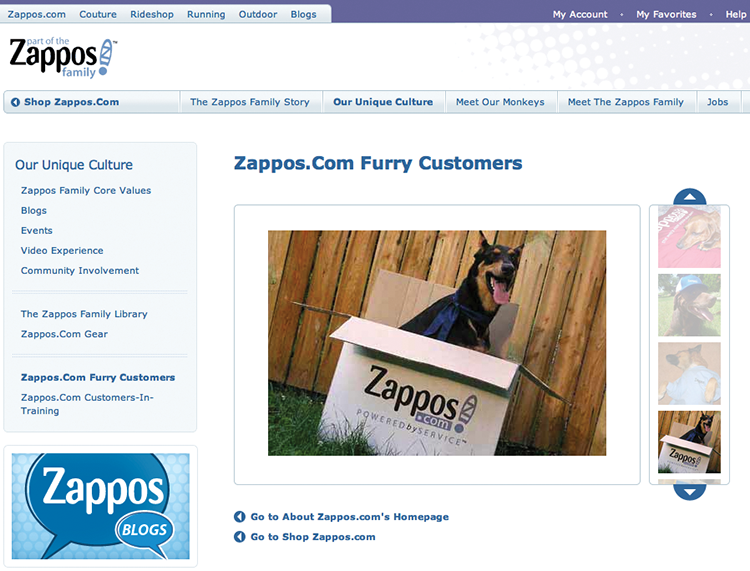
Creators of the chosen designs get a $2,000 cash prize plus $500 in store credit, but judging from comments posted on the site and elsewhere, its true value to contributors appears to be in the recognition, not the cash. The whole process from submission, through voting, to production of the chosen designs focuses on a sense of community, making customers feel important, central to the process, and powerful too. What better incentive could these customers have to purchase a T-shirt than having personally shepherded it through from design to finished product?
Threadless.com’s community gives T-shirt designers direct feedback on how likely it is that people would pay for their work. This helps the designers improve, but it also gives the company very strong indicators of which images to turn into products to sell online.
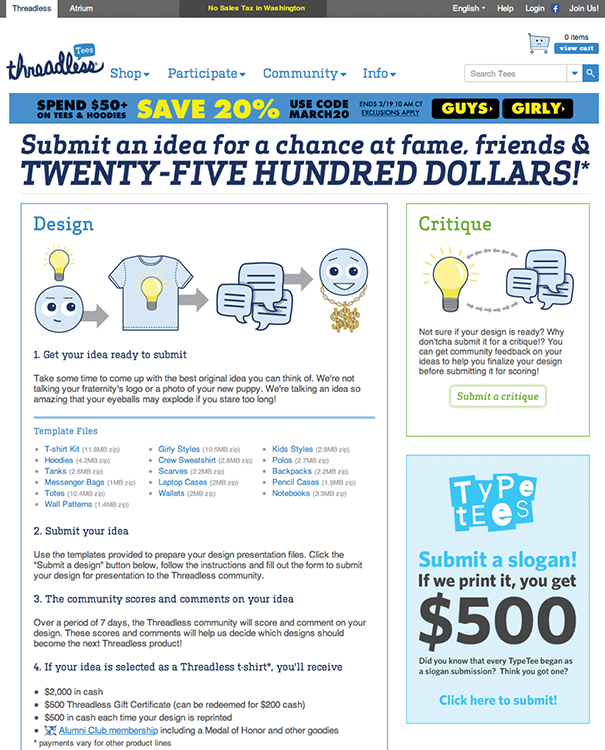
The community involvement doesn’t stop there. Much of Threadless’ advertising happens by word-of-mouth (although obviously every T-shirt is a walking billboard), and Threadless members’ feedback gets turned into product features in a visible way through the founder’s blog. Jake Nickell, the co-founder of Threadless, put it this way: “We are so much driven by our community that we don’t really make the decisions. We look at what the community wants and react to it, but we don’t make plans five years in advance. This company will grow to where customers want to take it.”
One of their popular artists, Brent Schoepf says, “I hope that the trend continues where anybody can make art and put it in the world for people to see and explore.”
The site has seen more than 200,000 submissions, which have been voted on more than 100 million times by their more than one and a half million registered users. They sell more than 10,000 T-shirts per month at prices ranging from $15 to $17. There’s obviously profit in making your users feel important.
- Give something away free to customers “because you are so important to us.” This could be a month’s free membership, free shipping, or any number of other low-cost (to you) items that still serve as a pleasant surprise to customers.
- Have an exclusive thing that only certain individuals get. Each “certain individual” need not know how many other “certain individuals” there are. It can be something mutually beneficial like an early-warning e-mail list that is open only to repeat customers, letting them know about deals before they are generally announced.
- Harness the power of your customers—so long as they feel like their opinions are respected, they will do free work for you, such as choosing the best items from a selection or policing your forums.
- Make it clear that your customers are important by giving them a place on your site. It could be something as simple as the capacity to comment on blog postings, but why not get more creative and choose “featured customers” or ask for customer submissions?
Manufacturing and maintaining envy in your products
I hope that the person who created the default “Sent from my iPhone” e-mail signature text for iOS devices got well rewarded for their work. It is the perfect embodiment of effortlessly viral aspirational content. Taken at face value it is little more than an advertisement for a product—something that benefits the company more than the customer. Yet users seem strangely reluctant to change it. This inertia stems at least in part from what that small phrase says about them as an individual. Even more than half a decade after the device’s release the phrase is still prevalent at the bottom of people’s e-mails, and it can’t just be because none of them can find out where to change the setting. It remains there because it’s boastful in a socially acceptable way.
Full-on destructive envy is the desire to have more than those around you. While that could lead to some pretty antisocial behavior, we’ve seen that its milder form—aspiration—can actually be quite a powerful motivational and persuasive factor.
We’ve covered ways to create desire for a product and to ensure that the product is one that people aspire to own by showing it in aspirational settings or being used by aspirational individuals so that people can visualize what it might give them “more” of. It’s possible to get people bought in before they’ve made the purchase by inviting them to be part of the family even in small ways like receiving news updates, playing with configuration options, or using demo versions.
Staying in benign envy is probably more useful than moving to destructive envy. A little bit of inequality aversion probably won’t hurt too much, but when people start making decisions based on limiting others’ gains, the community aspect of your product will suffer. A product that rewards individuals for helping others attain their aspirations helps keep envy under control, like the multiple levels of sales people in the Mary Kay hierarchy, where people higher in the chain are reliant on the success of those beneath them. Interestingly Mary Kay shares a feature with the online game World of Warcraft here, because both are smart enough to provide several interim levels of attainment to aspire to. There’s always a viable goal, and once it’s reached there’s another one just ahead to work towards. In both cases that means everyone who participates can have realistic and achievable aspirations.
Having achievable aspirations doesn’t mean completely leveling out the playing field. You can maintain benign envy by making differences in status and achievement apparent. Help customers advertise their status so they feel important. This advertising can occur simply by their overt use of your product (“Sent from my iPhone”) or by encouraging them to share their experiences using the product in the form of reviews or something more obtuse like Zappos’ dog photo gallery. This gives you free publicity and good review content. To moderate the amount of envy that is generated and to keep it aspirational, be sure to show how other people can achieve that goal themselves either through working for it (with constant reminders of their progress) or by paying to gain the status.
It’s very hard to make people desire and aspire to use products that are aesthetic duds, undifferentiated, or just plain broken. However, if you have a pleasing product that solves an interesting problem there are plenty of ways to build a buzz that creates a level of benign envy that will drive sales and adoption.
